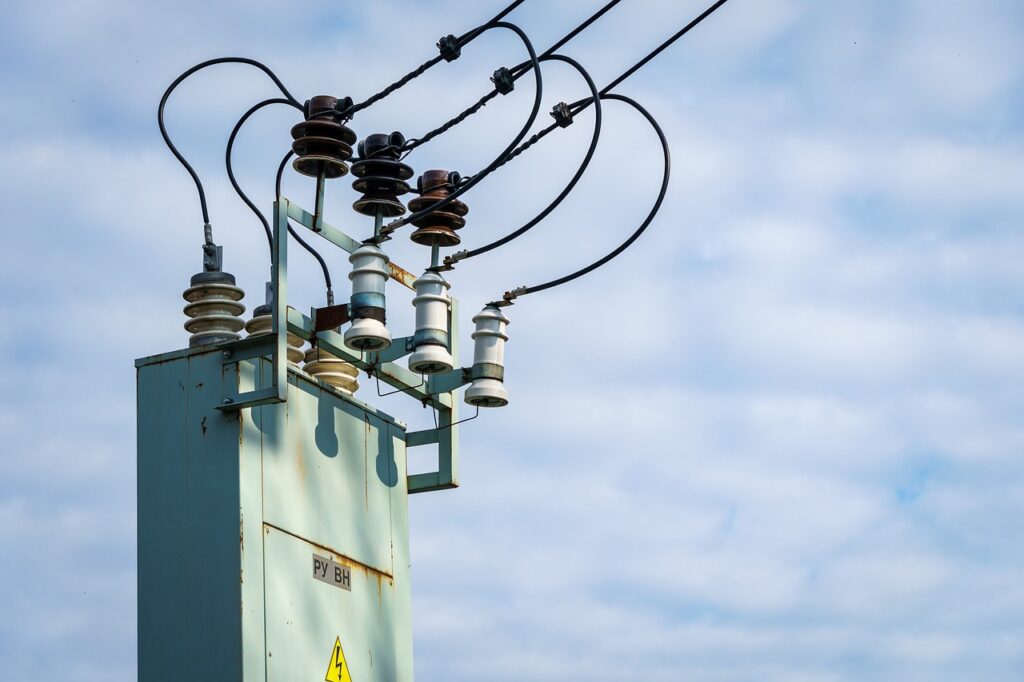Constructing a building beneath a power line involves navigating a complex landscape of safety concerns, legal regulations, and health considerations.
While it may be technically feasible in certain circumstances, such construction is generally discouraged due to the myriad risks and restrictions involved.
This article by the experts at Lion Buildings explores the various aspects of building under power lines, providing insights into the associated challenges.
Understanding the Risks
Constructing a building beneath power lines introduces a range of safety risks that are not always immediately apparent. One of the most critical concerns involves electromagnetic fields, or EMFs, which are invisible areas of energy associated with the use of electrical power. These EMFs are generated by high voltage power lines and are particularly concentrated in areas directly beneath or very close to them. While ongoing research continues to examine the extent of their effects, EMFs have been associated with potential health issues, and their presence alone may cause anxiety for individuals working or living in nearby structures.
The physical danger of being in close proximity to live electrical conductors cannot be overstated. Accidental contact with power lines can lead to severe injury or death through electric shock. Buildings constructed too close to these lines pose risks for workers during construction, for maintenance personnel performing future upgrades, and for residents or users of the building afterward. For example, using tall equipment such as ladders or cranes near power lines without sufficient clearance can inadvertently lead to electrocution or fires.
In addition to personal safety concerns, operational disruptions can also arise. Power companies need access to these lines for routine maintenance, emergency repairs, or infrastructure upgrades. Structures built under or too close to these lines may obstruct necessary access, causing delays or necessitating additional costs for rerouting or dismantling parts of the building. Furthermore, during certain maintenance activities, power supply might be temporarily halted, affecting any business operations, residential living conditions, or other activities dependent on continuous electricity.
Legal Framework in the United States
In the United States, legal oversight of building near or under power lines is comprehensive and involves multiple layers of regulation. These regulations are in place not only to protect people from injury but also to ensure the reliability and safety of the power grid. Federal, state, and local authorities all play roles in determining what is permissible and under what circumstances. Utility companies are also heavily involved in the approval and planning stages to ensure their infrastructure is not compromised.
The National Electrical Safety Code, or NESC, is one of the primary regulatory tools used to manage power line safety. Created by the Institute of Electrical and Electronics Engineers, the NESC outlines essential requirements for the safe design and operation of electrical power systems, including specific guidelines about the minimum clearance between power lines and any built structures. These clearances vary depending on the voltage carried by the line and the nature of the structure being constructed, but the goal is to eliminate the risk of electrical arcing or accidental contact.
The Occupational Safety and Health Administration also plays a significant role, particularly during construction. OSHA standards, such as OSHA 1926.1411, provide detailed rules for equipment movement and personnel activity around energized power lines. These rules are intended to protect workers during the building phase but have implications for permanent structures as well. Local governments enforce these federal standards through building code enforcement and permit processes. Anyone considering construction near power lines must seek clearance from local building authorities, who will review proposed plans to ensure they comply with all safety and zoning laws.
Health Considerations
Exposure to electromagnetic fields from high voltage power lines continues to be a source of public concern and scientific investigation. EMFs are generated whenever electrical current flows through a conductor, and the intensity of these fields is much greater near large transmission lines. While the general public is exposed to EMFs every day through devices like microwaves and cell phones, the fields from power lines are much stronger and may pose different kinds of risks when exposure is continuous and prolonged.
Numerous studies have examined the possible links between EMF exposure and a range of health issues. Some findings suggest an elevated risk of childhood leukemia for those living near high voltage power lines. A study from the University of Toronto and The Hospital for Sick Children found that children exposed to higher magnetic field levels at home were more likely to develop leukemia than those who were not. While these findings have sparked concern, other scientific reviews have concluded that evidence remains inconclusive or inconsistent. The debate is ongoing, and no scientific consensus has yet emerged, leaving room for precautionary measures.
Given the uncertainty surrounding EMF exposure, many health experts recommend minimizing time spent near power lines. This guidance is especially relevant when considering long term residential or commercial use of a structure built directly underneath or in close proximity to a transmission line. Even if no harm is ultimately proven, the psychological stress associated with perceived health threats can negatively impact quality of life. For these reasons, health considerations are a key factor in deciding against building under power lines, even when regulations technically allow it.
Insurance and Property Value Implications
Insurance companies assess risk when determining coverage eligibility and premium costs. Structures built under or near power lines represent a higher-than-normal risk category due to the potential for fire, electrical hazards, and liability issues. As a result, insurers may refuse to underwrite a policy, limit the types of coverage offered, or charge significantly higher premiums to offset their risk exposure. These additional costs can make such properties less attractive to potential investors or developers.
Property value is also adversely affected by the presence of overhead power lines. Numerous real estate studies have shown that homes and commercial buildings located near high voltage lines sell for less than comparable properties located farther away. This devaluation can be attributed to safety concerns, negative aesthetics, and perceived health risks. The constant visibility of power lines may make buyers feel uneasy or remind them of potential dangers, regardless of the actual risk involved. These psychological factors influence market behavior and reduce the pool of interested buyers.
Even in cases where safety concerns are addressed through engineering solutions or legal clearance, the stigma associated with building under power lines often remains. Appraisers and real estate professionals tend to be cautious when valuing properties near transmission lines, which can result in lower appraisals. This creates financial obstacles for current owners who want to sell and for future buyers who may struggle to obtain favorable mortgage terms. All these considerations make it clear that building under a power line is not just a technical or legal issue but also a financial one.
ure. However, other studies have found no conclusive evidence linking EMF exposure to adverse health effects. Given the uncertainty, it is prudent to minimize prolonged exposure by avoiding residential or commercial construction directly under power lines.
Insurance and Property Value Implications
Structures built under power lines may face challenges in obtaining insurance coverage due to the increased risk factors. Insurance companies might impose higher premiums or exclude certain coverages. Additionally, properties in close proximity to power lines often experience reduced market value, as potential buyers may be deterred by safety concerns and aesthetic considerations.
Alternative Solutions
If construction near power lines is unavoidable, consider the following alternatives to mitigate risks:
Relocation: Explore the possibility of relocating the building site to a safer distance from power lines.
Underground Lines: In some cases, utility companies may agree to relocate overhead lines underground, although this can be costly and is subject to regulatory approval.
Design Modifications: Adjust the building design to ensure compliance with clearance requirements and minimize exposure to EMFs.
Conclusion
Constructing a building under a power line involves navigating a complex landscape of safety risks, legal restrictions, and potential health concerns. In the United States, strict regulations such as the National Electrical Safety Code and OSHA standards are in place to prevent such developments and protect public welfare. Before considering construction near power lines, it is imperative to consult with local authorities, utility companies, and legal experts to ensure compliance with all applicable laws and to safeguard the well-being of occupants and the integrity of the power infrastructure.

